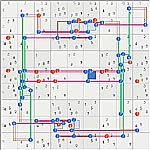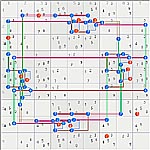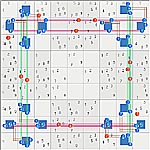I just came across Obi-Wahn's list of hardest multiple jelly puzzles in the Hardest Sudokus thread here and took a look at the first puzzle:
Coloin-04/13-1414, which is rated at 11.8 on the SER scale. This puzzle has two different initial high symmetry loops, one of which is similar to SteveK's original SK loop from Easter Monster. The other is about the same size, more complex structurally, and wipes out 19 candidates almost solving the puzzle. Both loops are shown below.
As additional loops reveal their diverse logical nature, it becomes clear that the original SK loop is one of a number of possible logic structures, many of which are more complex, and can be harder to find. To see this, I have compared 10 loops from 6 puzzles, including Fata Morgana, Easter Monster, Tungsten Rod, Strmckr's Puzzle, and Golden nugget. Golden Nugget is included because its morphed symmetrical form, here has similar kinds of loops.
The table below summarizes several loop properties. The puzzles are listed in order of different kinds of complexity found in the loops. Properties include the presence of bi-value sets, the number of each type of set used, number of candidates removed, and the logic rank. Rank 0, fish like logic, is common but several loops have mixed rank logic that promotes some of the links to rank 0. Core refers loops with additional logic in the center box. The loops have other logical properties, not listed, such as symmetric or anti-symmetric digit layers, and layers that have the same or different logic. It's possible these loops are just part of an entire family of logical structures, just like fish.
I have added a new page to my website: Inside the Great Monsters,
that compares all 10 loops, where I also try to capture some of the natural beauty of Sudoku logic. While spatial symmetries must be 4-fold, some of these loops show 3-fold logical symmetries that can be either symmetric or anti-symmetric.
As more loops are uncovered, I will add them to this summary information, and provide additional links to data.
Summary Table
- Code: Select all
------ strong sets -------- remaining
2-value 3-value 4/5-value core logic elim. difficulty
Fata Morgana loop-1 --- 8 3 yes rank 0,1 2
Fata Morgana loop-2 --- 14 - yes rank 0,1 6 medium
Golden Nugget (morph) 1 10 6 yes rank 0,1 1 hard
Tungsten Rod 1 6 2 yes rank 1 2 medium
Coloin-04/13-1414 loop-1 4 11 2 yes rank 0 19 easy
Coloin-04/13-1414 loop-2 2 10 4 no rank 0 14
Coloin-04/13-1414 loop-3 02 16 4 no rank 0 14
Easter Monster 4 12 - no rank 0 13 hard
StrmCkr's Puzzle loop-1A 4 12 - no rank 0 9
StrmCkr's Puzzle loop-1B --- --- 12 no rank 0 9
StrmCkr's Puzzle move 2 --- 4 4 yes rank 0 12 v. hard
Coloin-04/13-1414 loop-1
Note: all cordinates are in NRC format (digit, row, column), = strong link, | weak link. Targets and not included in the logic-grams below for clarity, but are in the 2D grid images at the bootom, and in the set logic listing.
- Code: Select all
COL1 51 Nodes, Rank 0: Removes 19 Candidates
17 Sets = {167r2 167r8 1267c2 1267c8 5n6 2b28}
17 Links = {2r3 127r5 2r9 2n56 4n8 6n2 8n45 7b1 16b3 16b7 7b9}
--> (7b1) => r1c3<>7, (2n5) => r2c5<>3, (2n5) => r2c5<>8, (2n6) => r2c6<>3,
(2r3) => r3c1<>2, (4n8) => r4c8<>9, (2r5) => r5c1<>2, (1r5) => r5c3<>1,
(7r5) => r5c3<>7, (1r5) => r5c4<>1, (2r5) => r5c4<>2, (7r5) => r5c4<>7,
(1r5) => r5c7<>1, (2r5) => r5c7<>2, (7r5) => r5c9<>7, (7b9) => r7c9<>7,
(8n4) => r8c4<>5, (8n5) => r8c5<>4, (2r9) => r9c7<>2
1R8: 185==184============183
| | |
1C2: | | 172=======162============152
| | | |
1C8: | | | 158==148============138
| | | | | |
1R2: | | | | | 127=======126==125
2B8: 285==284=======294 | | | | |
| | 295 | | | | |
| | 296 | | | | |
| | | | | | | |
2C8: | | 298=============|========258===|===248 | |
| | | | | | | |
5N6: | | | 756==256==156 | | | } Central core set
| | | | | | | |
2C2: | | 262===|===252========|========232 | |
| | | | | | | |
2B2: | | | | | 234============226==225
| | | | | 235 | |
6R8: | 684=================681 | | | | |
| | | | | | | | }
6C2: | | 692==662 | | | | } Bi-value
6C8: | | | | 648==618 | | } sets layer
| | | | | | | | }
6R2: | | | | | 629=================626 | }
7R8: 785==784==789 | | | | |
| | | | | |
7C2: | 762==752=============|==================712 | |
| | | | | |
7R2: | | | 723==726==725
7C8: 778======================758============748
Coloin-04/13-1414 loop-2
- Code: Select all
COL2 54 Nodes, Rank 0: Removes 14 candidates
16 Sets = {1r28 2r28 6r2468 17c2 17c8 2b46 7b28}
16 Links = {7r17 26c1 2c7 6c9 2n56 4n8 5n28 6n2 8n45 1b37}
--> (7r1) => r1c3<>7, (2n5) => r2c5<>3, (2n5) => r2c5<>8, (2n6) => r2c6<>3,
(2c1) => r3c1<>2, (4n8) => r4c8<>9, (5n2) => r5c2<>4, (5n2) => r5c2<>8,
(5n8) => r5c8<>3, (5n8) => r5c8<>9, (7r7) => r7c9<>7, (8n4) => r8c4<>5,
(8n5) => r8c5<>4, (2c7) => r9c7<>2
7B2: 726=======725===============================================714
| | 715
| | 716
2R2: 226=======225==========================================221 |
| | | |
1R2: 126==127==125 | |
7C2: | | | 712==752=======762
| | | | |
2B4: | | 241=======252=======262
| | 251 | |
| | 261 | |
1C2: | | 152==172==162
2R8: | | 287============284==285 | |
| | | | | | |
7B8: | | | 774=======784==785 | |
| | | 775 | | | |
| | | 776 | | | |
| | | | | | | |
2B6: | | 258==248=======247 | | | | |
| | | | 257 | | | | |
| | | | 267 | | | | |
| | | | | | | | |
7C8: | | 758==748============778 | | | |
1R8: | | | | 184==185=================183 |
| | | | | |
6R8: | | | | 681==684 |
| | | | | |
6R6: | | | | 669============661================================662
| | | | | |
6R4: | | | 648==649============641
| | | | |
1C8: | 138=======158==148 |
| |
6R2: 626======================629
Coloin-04/13-1414 loop-3, classic SK type
- Code: Select all
COL3 48 Nodes, Rank 0:
16 Sets = {1n28 2n1379 3n28 7n28 8n1379 9n28}
16 Links = {38r2 45r8 48c2 39c8 27b1 16b3 16b7 27b9}
--> (7b1) => r1c3<>7, (3r2) => r2c5<>3, (8r2) => r2c5<>8, (3r2) => r2c6<>3,
(2b1) => r3c1<>2, (9c8) => r4c8<>9, (4c2) => r5c2<>4, (8c2) => r5c2<>8,
(3c8) => r5c8<>3, (9c8) => r5c8<>9, (7b9) => r7c9<>7, (5r8) => r8c4<>5,
(4r8) => r8c5<>4, (2b9) => r9c7<>2
7N2: 472==872===================================================================172
| | |
9N2: 492==892==============================================================692 |
| | | |
3N2: 432==832=======232 | |
| | | | |
1N2: 412==812==712 | | |
2N1: | 221==321==821 | |
| | | | |
2N3: 723=======323==823 | |
| | | |
2N9: 329==829=======629 | |
| | | | |
2N7: 327==827==127 | | |
1N8: | 618==318==918 | |
| | | | |
3N8: 138=======338==938 | |
| | | |
7N8: 378==978=======778 | |
| | | | |
9N8: 398==998==298 | | |
8N1: | | 481==581==681 |
| | | | |
8N3: | | 483==583=======183
| | | |
8N9: | 789==489==589
| | |
8N7: 287=======487==587
Thumbs to images: left to right loop COL1, COL2, COL3.
 ,
,

Edit: Added loop COL3, suggested by Ronk. 2) fixed broken link to website 3) removed statement concerning methodologies

